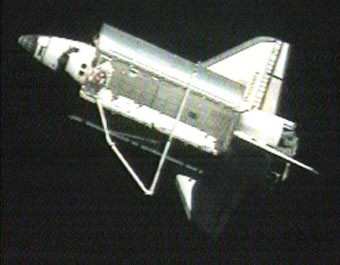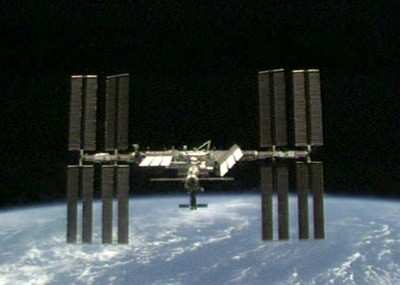Thu, Mar 26, 2009
Undocks From ISS After Nine-Day Stay
 The shuttle Discovery separated from
the International Space Station at 3:53 pm EDT Wednesday, after
spending 9 days, 20 hours and 10 minutes docked to the orbital
outpost.
The shuttle Discovery separated from
the International Space Station at 3:53 pm EDT Wednesday, after
spending 9 days, 20 hours and 10 minutes docked to the orbital
outpost.
Reuters reports station commander Mike Fincke told the Discovery
crew as they gathered to say good-bye, "It was really great having
you up here. You've made the space station much better than it was
before." Fincke, along with flight engineer Yury Lonchakov, will
return to Earth next month after a six-month stay on the
station.
They'll be replaced by Commander Gennady Padalka and flight
engineer Michael Barratt. The two will join second-time space
tourist Charles Simonyi aboard a Russian Soyuz vehicle scheduled
for launch Thursday morning from the Baikonur Cosmodrome in
Kazakhstan.
The third member of their crew is Japan's Koichi Wakata, who
already made the trip with Discovery on STS-119. He replaced
astronaut Sandra Magnus, who is returning onboard Discovery from
her six-month stay onboard the station.
On Thursday, the crew will wake at 5:13 am and perform a late
inspection of Discovery's thermal protection system using the
shuttle robotic arm and the Orbital Boom Sensor System around 9:28
am. This procedure will last for approximately five hours before
the OBSS and arm are then berthed in Discovery’s payload bay
around 2:43 pm. Landing is scheduled for Saturday at the Kennedy
Space Center in Florida.

The STS-119 crew flew the S6 truss segment and installed the
final set of power-generating solar arrays to the International
Space Station. The S6 truss completes the backbone of the station
and provides one-fourth of the total power needed to support a crew
of six.
The expansion of the normal crew size also hinges on proper
functioning of a troublesome liquid recycling system, which
reprocesses urine into drinkable water. Discovery delivered a new
part, and is carrying home a sample of the treated water for
analysis to see if it is drinkable.
More News
From 2023 (YouTube Version): Legacy of a Titan Robert (Bob) Anderson Hoover was a fighter pilot, test pilot, flight instructor, and air show superstar. More so, Bob Hoover was an i>[...]
Get The Latest in Aviation News NOW on Instagram Are you on Instagram yet? It's been around for a few years, quietly picking up traction mostly thanks to everybody's new obsession >[...]
Aero Linx: B-52H Stratofortress The B-52H Stratofortress is a long-range, heavy bomber that can perform a variety of missions. The bomber is capable of flying at high subsonic spee>[...]
Altimeter Setting The barometric pressure reading used to adjust a pressure altimeter for variations in existing atmospheric pressure or to the standard altimeter setting (29.92).>[...]
"Knowing that we play an active part in bettering people's lives is extremely rewarding. My team and I are very thankful for the opportunity to be here and to help in any way we ca>[...]
 Classic Aero-TV: Remembering Bob Hoover
Classic Aero-TV: Remembering Bob Hoover ANN FAQ: Follow Us On Instagram!
ANN FAQ: Follow Us On Instagram! ANN's Daily Aero-Linx (05.15.24)
ANN's Daily Aero-Linx (05.15.24) ANN's Daily Aero-Term (05.15.24):Altimeter Setting
ANN's Daily Aero-Term (05.15.24):Altimeter Setting Aero-News: Quote of the Day (05.16.24)
Aero-News: Quote of the Day (05.16.24)




